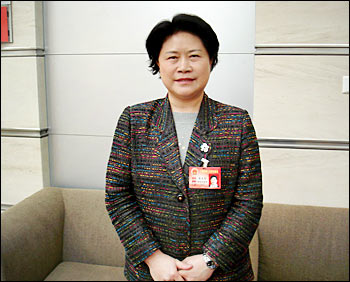The Chinese government has pledged more efforts to protect the country's "Golden Waterway", the Yangtze River, Cai Qihua, a Hubei deputy attending the ongoing Fourth Session of the 10th National People's Congress from March 5 to 14 in Beijing, said in an exclusive interview with china.org.cn on Sunday.
Ms Cai is the director of the Yangtze River Conservancy Commission under the Ministry of Water Resources.

"If the objectives of building a resource-conserving and environment-friendly society, as listed in the 11th Five-Year Development Guidelines (2006-2010), are met, this will be an extremely positive result for the Yangtze River drainage area, as well as for the whole country," she said.
The 6,211-kilometer-long Yangtze, also known as China's Golden Waterway, is the longest in China. Its drainage areas include the Tibet Autonomous Region, Guangxi Zhuang Autonomous Region, Qinghai, Sichuan, Yunan, Guizhou, Gansu, Shaanxi, Hubei, Hunan, Henan, Jiangxi, Anhui, Jiangsu, Zhejiang and Fujian provinces, and Chongqing and Shanghai municipalities.
The water resources in these drainage areas account for 35 percent of the country's total. Potential hydropower generation is half of the country's total. Population in these areas is 427 million or a third of China's total, while their combined gross domestic product (GDP) makes up an average 35 percent of the country's total.
Despite these promising figures, only 15.2 percent of these water resources and 27 percent of its hydropower-generation potential are being actualized.
"The development of the Yangtze River economic zone concerns not only the interests of the people in the drainage areas, but also plays a crucial role in the country's overall economic development pattern."
Cai believes that the success in the Yangtze project could sustain China's economic and social development.
The challenges facing further development include a strain on resources and pollution. This is because of the sheer size of the overall population in the drainage areas and a concentration of industry along the river.
"To ensure the orderly development of the Yangtze water source, our commission has set 14 restrictive indicators to monitor development and its impact on water quality and the surrounding environments. For example, hydropower utilization is to be no more than 60 percent of the total, and water consumption in the drainage areas is to be no more than 30 percent of national levels.
On the subject of the use of resources, the central government launched the South-North Water Diversion Project in December 2002 to ease water shortages in north China, especially in Beijing and Tianjin.
The project involves three water diversion routes, all of which take water directly from the Yangtze.
Cai pointed out that the project has little impact on the water resources of the Yangtze. She said: "The total volume of water being diverted is only 5 percent of what's is available."
But she added: "During low flow season, the lower reaches of the Yangtze, the river mouth in particular, are vulnerable to salt tides."
To address this problem, Cai said that her commission intends to optimize planned water conservancy projects, the Three Gorges Reservoir project for instance, to adjust water drainage volumes.
She also stressed the importance of a change in the administrative system of the drainage areas.
"A national comprehensive administrative structure comprising deputy governors from the 19 provinces and municipalities in the Yangtze River drainage areas should be set up in order to better harness the potential of the river."
(China.org.cn by staff reporter Tang Fuchun, March 13, 2006)